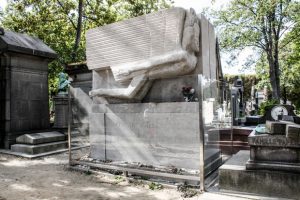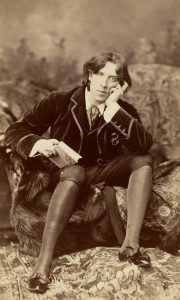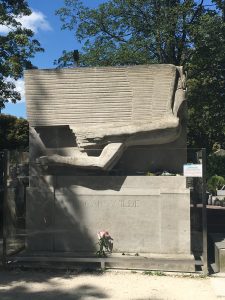
I am among the world’s dorkiest tourists. I don’t go where the tour books recommend…I perform book pilgrimages, often to some genuinely remote and not-very-picturesque places. Once, I wandered around a rural Dublin neighborhood for two hours trying to figure out in which house Bram Stoker was born. I gagged down an egg cream in New Mexico, because I was reading Harriet the Spy at the time, and wanted to taste her favorite drink (Harriet and I have very different tastes in soda-fountain faire…)
So during this trip, I decided to make another book pilgrimage. The Eurostar–that train that links England to mainland Europe via a tunnel under the English Channel–was having a sale, so I decided to visit Oscar Wilde’s grave.

We all have stories that save us, and Oscar Wilde provided many of those stories for me. His poems taught me how to feel poetry; I still am not good at the academic analysis of verse, but Oscar didn’t much care if you “got” it, as long as you felt something…and feel something, I did. His plays made me laugh during my high school years when nothing else seemed particularly funny at all. But most of all, his life story taught me that it wasn’t just ok to be different–that you had an obligation to be honest with yourself, and be the person you want to be–and to respect others for being honest, as well. That hypocrisy was the worst crime, and beauty was the highest achievement, whether that was a beautiful piece of art, a beautiful friendship, or a beautiful life. I was, and continue to be inspired by Oscar’s bravery and intellect and sense of humor–I named by cat after him, for Heaven’s sake, is there any higher honor?

So, anyways, I have made a number of pilgrimages to Oscar…I creeped out some nice London residents when I was in high school by lurking outside the house he once owned on Tite Street. I convinced by really very kind cousin to take me up to Portora School in Enniskillen so I could see the school he attended as a child. And this time around, I made it to his grave.
 Why Paris? Oscar Wilde was sentenced to two years’ hard labor in 1895 for the crime of ‘gross indecency’ (homosexual activity, which was illegal in England until 1967). The trial was such an overwhelmingly large media event that it destroyed Wilde’s name and reputation. His wife was forced to divorce him by her family; his young children had their surnames legally changed to distance themselves from their father; many of his former friends refused to have anything to do with him. When he was released from prison in 1898, Wilde left England forever and moved to Paris where he could live in relative anonymity. He died in Paris in 1900, and his best friend, Robbie Ross (another of my personal heroes) arranged for him to be buried in Père Lachaise Cemetery. Eight years later, Ross had received some two thousand pounds from an anonymous donor to build a marker for Wilde’s grave. He chose American sculptor Jacob Epstein, who moved in the same circles as Ross.
Why Paris? Oscar Wilde was sentenced to two years’ hard labor in 1895 for the crime of ‘gross indecency’ (homosexual activity, which was illegal in England until 1967). The trial was such an overwhelmingly large media event that it destroyed Wilde’s name and reputation. His wife was forced to divorce him by her family; his young children had their surnames legally changed to distance themselves from their father; many of his former friends refused to have anything to do with him. When he was released from prison in 1898, Wilde left England forever and moved to Paris where he could live in relative anonymity. He died in Paris in 1900, and his best friend, Robbie Ross (another of my personal heroes) arranged for him to be buried in Père Lachaise Cemetery. Eight years later, Ross had received some two thousand pounds from an anonymous donor to build a marker for Wilde’s grave. He chose American sculptor Jacob Epstein, who moved in the same circles as Ross.

Epstein encountered any number of difficulties in completing his assignment; the French government refused to recognize it as “art”, and therefore charged £120 before Epstein could transfer his work to Wilde’s grave. He had to bribe police officers to look the other way as he worked at the grave site, because he was crafted a nude, and was constantly running the risk of being prosecuted for lewdness. The officials at Père Lachaise kept trying to cover up bits of his nude figure so as to avoid offending the public, making Epstein so furious he refused to attend the unveiling.
..So, back to my story: Père Lachaise itself is an enormous (110 acres), and very well-known cemetery, serving as the resting place for a number of very famous people (other than Oscar), including Frederic Chopin, Jim Morrison, Marcel Proust, Gertrude Stein and Alice B. Toklas, and Eugène Delacroix. I know about Delacroix, especially, since a not-very-happy Frenchman chastised me for walking right by Delacroix’s grave without paying him proper attention (I apologized to Delacroix, by the way).

Oscar Wilde is buried towards the Porte Gambetta side of the cemetery (number 1 in the map above), and, for all the trouble Epstein had in crafting his monument, the thing itself is remarkable, and makes the gravesite a visually arresting one, surrounded as it is by very traditional late-19th century monoliths and tablets. I should have been expecting the big plexiglass barrier around the grave; for years, people have been coming up and kissing the monument, leaving big lipstick marks all over it, and the chemicals in the cosmetics were actually damaging the stone of the grave irreparably, making this “kiss proof guard” a necessity in 2011.
What surprised me most of all, though, were the number of people who were there. There wasn’t a throng by any means, but I had brought my lunch with me to eat with Oscar, and in the 45 minutes or so that I sat on the stump near his grave, I was never alone. One man even came up with a bunch of flowers and dropped a red rose over the kiss barrier so it lay on the grave. People came, just to sit near Oscar’s grave, to talk with their companions about his works, or his life, or what those things meant to each person, specifically.
For decades after Oscar’s death, his plays were not performed, his poems were not read, and it was assumed by many that his name would fade away eventually, or remained forever tainted by the scandal that surrounded his imprisonment. It was for that reason that a quote from his poem The Ballad of Reading Gaol was carved onto the back of his grave:
And alien tears will fill for him
Pity’s long-broken urn,
For his mourners will be outcast men,
And outcasts always mourn.
But what I saw, instead, were a lot of other people whom Wilde had saved, paying their respects out of love and respect, not pity. And that made the whole pilgrimage worthwhile.
